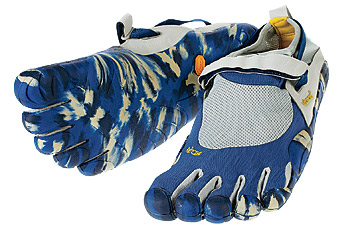
Vibram Five Fingers
In retrospect, the timing of my barefoot-running experiment — in New York City, in January, in the middle of one of the worst cold snaps in memory — may not have been ideal. But I was willing to risk toe frostbite to find out why a growing number of trainers and scientists believe that ditching cushioned soles might be the best way to protect joggers against chronic injuries.
Because the human foot has relatively little padding on the heel, barefoot runners tread more lightly, landing on the outer part of the midfoot and then rolling inward. Cushiony running shoes, by contrast, encourage a stiff heel-to-toe stride that could lead to injury. In the December issue of a journal put out by the American Academy of Physical Medicine & Rehabilitation, researchers concluded that running in shoes exerts more stress on the knee, hip and ankle than does running barefoot or walking in high heels. "We evolved to run barefoot, and when we put shoes on, we're taking away the function of the foot," says Irene Davis, director of the University of Delaware Running Injury Clinic.
Interest in barefoot running has ramped up in recent months with Christopher McDougall's best seller, Born to Run, which follows Mexico's Tarahumara Indians, who routinely run ultra-marathons wearing thin rubber sandals or no shoes at all. But many podiatrists point out that there are little data on the long-term effects of going barefoot, and they urge average runners to show caution before they chuck their Nikes.
For me, that meant keeping my barefoot runs relatively short — 1 mile (0.6 km) or less — and running in Vibram Five Fingers, thin rubber foot gloves that protect my tender soles from debris. I found that my stride changed naturally — lighter on the heel and shorter — which put more stress on my calves. That led to some temporary soreness, but eventually my too-often-stiff knees and back felt better than they had in a long time. For now, I'm mostly sticking with sneakers, but I might try my barefoot experiment again. Maybe in the spring, or whenever my toes thaw.
